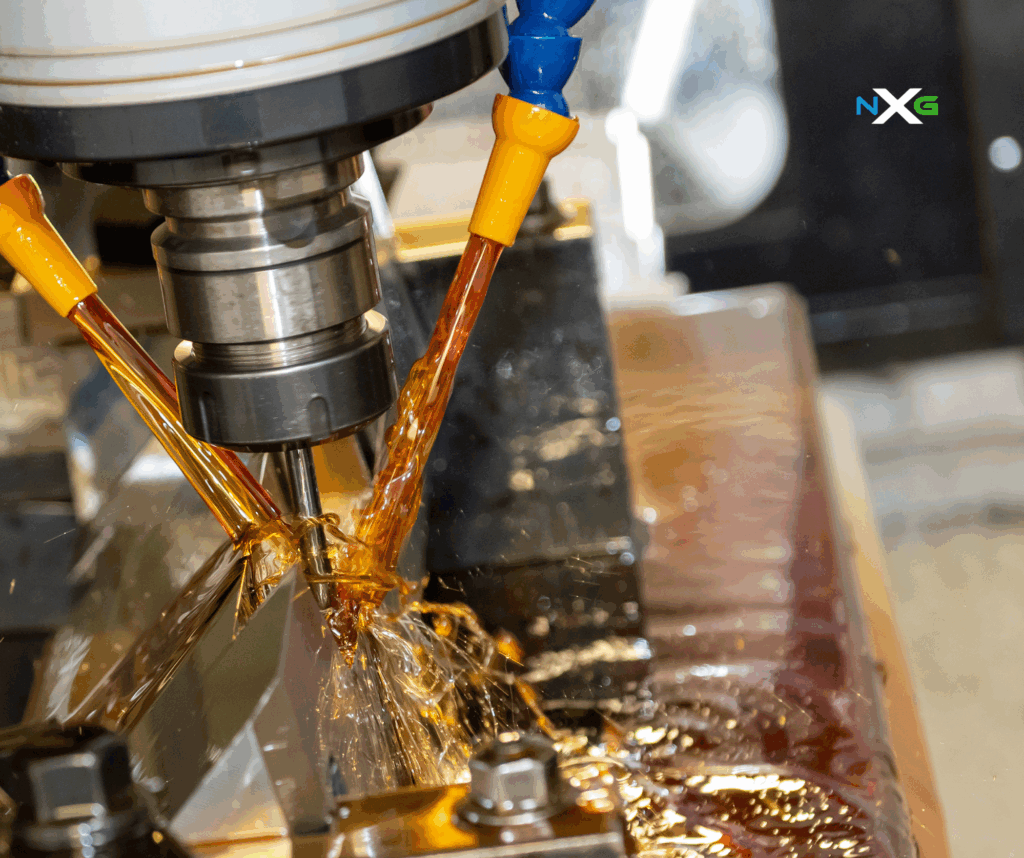Coolants in Metal Machining: What to Know
In the world of precision machining, coolant is more than just a fluid, it’s a critical factor that can directly impact tool life, surface finish, cycle times, and overall shop efficiency. Whether you’re cutting steel, aluminum, titanium, or exotic alloys, the type of coolant you use, and how you use it, can make or break the process.
At NEXGEN Tooling, we engineer our cutting tools for peak performance. But even the best tool needs the right support to shine. In this article, we break down the common types of coolants used in metal machining, their pros and cons, and key best practices to follow no matter what fluid you choose.
Types of Coolants in Metal Machining
1. Soluble Oils (Emulsions)
Soluble oils are the most traditional form of coolant, made by mixing oil into water with emulsifiers.
Pros:
- Good lubricity and cooling properties
- Versatile for a wide range of metals
- Generally affordable and easy to use
Cons:
- Can become rancid if not maintained properly
- Higher risk of microbial growth and foul odors
- More frequent maintenance and filtration required
Best For: General-purpose machining, especially on low- to medium-strength steels and cast iron.
2. Synthetic Coolants
Synthetic coolants are water-based solutions that contain no mineral oil. They rely on chemical additives for lubrication and corrosion protection.
Pros:
- Excellent cooling performance
- Cleaner-running systems (no sticky residues)
- Low foaming, especially useful in high-pressure applications
Cons:
- Lower lubricity compared to oil-based coolants
- May require corrosion inhibitors depending on the machine and materials
- Slightly more expensive up front
Best For: High-speed machining, aerospace alloys, and fine surface finish applications.
3. Semi-Synthetic Coolants
These combine the benefits of synthetic and soluble oils, using a blend of oil and synthetic fluids.
Pros:
- Balanced cooling and lubrication
- Reduced residue and microbial growth compared to soluble oils
- Flexible for a variety of materials and processes
Cons:
- Still requires careful concentration control
- More expensive than soluble oil
Best For: Mixed-material shops or environments needing both lubrication and heat dissipation.
4. Straight Oils (Neat Oils)
Straight oils are non-emulsifiable and used without dilution. They are typically composed of mineral or petroleum oils, sometimes with additives.

Pros:
- Superior lubricity for minimizing tool wear
- Excellent rust prevention and surface finish
- Best for difficult-to-machine materials
Cons:
- Poor heat dissipation (can cause thermal expansion issues)
- High misting potential
- Increased fire risk and potential health hazards with prolonged exposure
Best For: Slow-speed machining, deep hole drilling, tapping, and cutting tough alloys like Inconel or stainless steel.
Best Practices, No Matter What You Choose
Regardless of the coolant type, these tips will help you get the most out of your machining process and protect your investment in tooling:
✅Maintain Proper Concentration
Using a refractometer to regularly monitor and adjust coolant concentration helps prevent corrosion, foaming, and tool failure.
✅Ensure Good Filtration and Circulation
Clean coolant = longer tool life. Filtration systems remove chips, fines, and bacteria, preserving coolant performance.
✅Monitor Temperature and Flow
Coolant that’s too hot loses effectiveness. Maintain consistent flow and pressure, especially in high-speed machining.
✅Use Proper Application Techniques
Flood, mist, through-tool, or high-pressure? The right delivery method can drastically improve chip evacuation and cooling, especially with coated tools or high-performance geometries.
✅Respect Material-Specific Needs
Aluminum prefers coolant with anti-staining additives. Titanium needs maximum heat control. Tailor your coolant to the metal.
Final Thoughts
Coolant choice is not one-size-fits-all, it’s a critical part of your cutting strategy. Whether you’re using high-speed tools on aluminum or threading stainless steel, the right coolant ensures you’re not just cutting parts, you’re cutting smarter.
At NEXGEN, we’re committed to helping machinists unlock peak performance. If you’re not sure which coolant best supports your application, reach out to our team or your coolant supplier. The right tool, the right fluid, and the right process, that’s the formula for productivity.
Have questions about optimizing your cutting process?
Contact us at sales@nexgentooling.com or follow us on social media for more machining tips.
Find Posts
Need help deciding?
Talk to our product experts!
